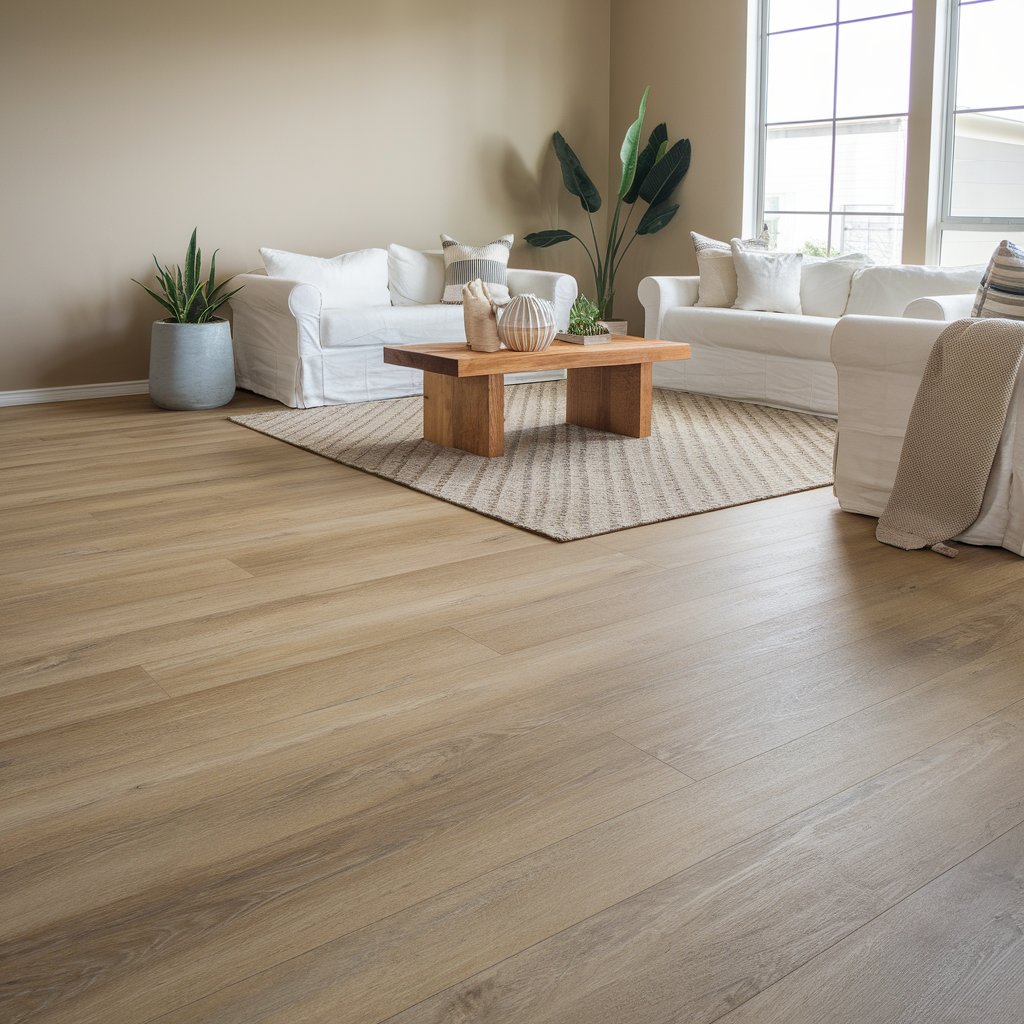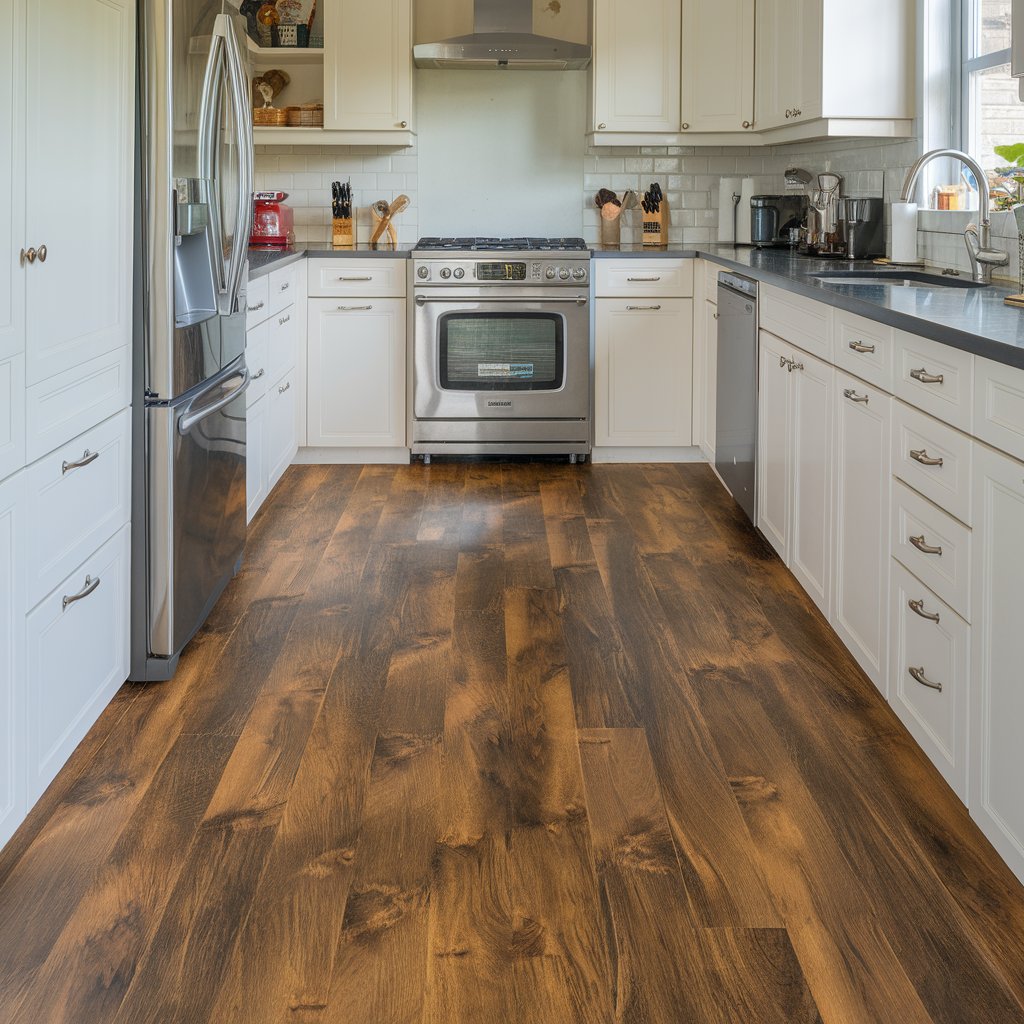
Blog test
How Long Does Laminate Flooring Last? Discover Its Average Lifespan
Laminate flooring, characterized by high-quality materials and routine care, typically lasts 15 to 25 years. With ideal conditions and meticulous maintenance, its lifespan can extend up to 30 years. Installation quality, foot traffic levels, and environmental conditions shape the product’s lasting quality. Efficiency in moisture control and protective measures, like furniture pads and area rugs, are essential. Understanding these factors allows for longevity maximization, and deeper insights await further exploration.
Key Takeaways
- The average life of laminate flooring ranges from 15 to 25 years, depends on the quality and maintenance.
- High-quality laminate can last up to 30 years under ideal conditions.
- Proper installation and regular maintenance are crucial for maximizing flooring’s life expectancy.
- Laminate flooring generally has a shorter lifespan compared to hardwood and tile flooring.
- Signs of wear like chipping, warping, and fading indicate it’s time to consider replacement.
What is the Average Lifespan of Laminate Flooring?
The average lifespan of flooring is contingent upon several critical factors, including the quality of the product, installation practices, and the level of foot traffic it endures.
When compared to other flooring choices, laminate typically exhibits a lifespan ranging from 15 to 25 years, which can be extended with high-quality materials and proper maintain.
High-quality laminate flooring, engineered with advanced protective coatings and robust core materials, may sustain its aesthetic and functional properties for up to three decades under ideal conditions.

Factors Affecting the Laminate Flooring Lifespan
While laminate flooring is celebrated for its durability and cost-effectiveness, several factors intricately influence its lifespan.
The laminate flooring lifespan is greatly impacted by wear and tear, particularly in areas with high foot traffic. Proper care and maintenance are vital to preserving the surface integrity and extending the lifespan.
The quality of the laminate itself plays an important role; heavy quality laminate generally offers enhanced durability and a longer average lifespan compared to lower-grade alternatives.
Additionally, to extend the lifespan, avoiding scratches through the usage of protective pads under furniture and ensuring regular cleaning can mitigate damage.
Fundamentally, a combination of superior material quality and diligent maintenance practices is essential for maximizing the life expectancy of laminate flooring.
Comparing the Lifespan of Laminate to Other Floors
Although laminate flooring is renowned for its durability and cost-effectiveness, its lifespan varies when compared to other types of flooring. The average lifespan of laminate flooring is generally between 15-25 years, contingent on factors such as quality laminate, wear layer, and maintenance.
- Hardwood Flooring: Known for its exceptional durability, hardwood can last upwards of 50–100 years with proper maintenance and refinishing. Laminate flooring, while durable, typically does not last as long as hardwood.
- Vinyl Flooring: With durability comparable to quality laminate, vinyl flooring typically lasts 10-20 years, depending on the wear layer and exposure to foot traffic.
- Tile Flooring: This type is renowned for its resilience and can easily last more than 50 years, requiring minimal maintenance.
Understanding these variances aids in informed flooring decisions.
How Long Can High Quality Laminate Last?
High-quality flooring, distinguished by its superior construction and robust wear layer, exhibits an average lifespan. This longevity is attributed to the quality of the product, as thicker laminate offers enhanced durability. Typically, laminate flooring consists of multiple layers, including a high-density core and a protective top layer, which contribute to its strength and resilience. Proper care and maintenance are essential to extend its lifespan, ensuring the flooring lasts beyond its typical expectancy. Factors such as consistent cleaning, avoiding excessive moisture, and using protective pads can notably influence the life of laminate flooring.
|
Factor |
Impact on Lifespan |
|
Thickness |
Increases durability |
|
Wear Layer Quality |
Enhances wear resistance |
|
Maintenance |
Prolongs lifespan |
|
Environmental |
Reduces deterioration |
Thus, heavy quality laminate stands as a resilient flooring choice that requires proper maintenance.
How to Extend the Lifespan of Your Laminate Floors
To maximize the life of laminate flooring, adherence to meticulous care and maintenance protocols is paramount, which includes routine cleaning and the use of appropriate cleaning agents to prevent surface damage.
The significance of professional installation cannot be overstated, as it guarantees the integrity of the flooring structure and minimizes the potential for premature wear.
Selecting a laminate flooring that aligns with the specific traffic and environmental conditions of the intended space is equally critical, as it enhances both durability and performance.
Proper Maintenance and Care Tips
Maintaining laminate flooring requires diligence and a strategic approach to guarantee its longevity. Proper care and maintenance are essential to extend the life of laminate floors, as their lifespan is greatly impacted by the level of traffic they endure.
Regular maintenance is important, especially in areas with heavy foot traffic that might experience more wear and tear. Proper maintenance is key to preserving their aesthetic and functional integrity.
- Regular Dusting and Sweeping: Minimize surface abrasion by removing grit and debris with regular sweeping or vacuuming.
- Moisture Control: Use a damp mop instead of a wet mop to prevent water damage.
- Protective Measures: Utilize area rugs in high-traffic zones to reduce direct wear on the laminate surface.
Importance of Proper Installation
When considering the life of laminate flooring, proper installation emerges as a critical factor that can greatly impact durability and performance. Incorrect installation may compromise the quality of the flooring, causing it to buckle or warp over time.
To guarantee flooring lasts as long as possible, meticulous attention to subfloor preparation, acclimatization of materials, and adherence to manufacturer guidelines is essential. The way laminate flooring is installed significantly affects its durability, as even higher-quality laminate can underperform if improperly installed.
Utilizing professional installers with expertise in laminate systems can enhance the flooring’s lifespan. Ultimately, ensuring that the flooring last necessitates a focus on proper installation techniques, contributing to the overall durability and performance of the laminate.

Choosing the Right Flooring Option for Your Needs
Selecting the right flooring for your home involves several vital considerations to maximize the life of your laminate floors.
- Quality of Laminate Flooring: Investing in high-quality laminate is paramount. Superior materials often yield a more durable product, directly impact their lifespan of your floors.
- Durability Requirements: Choose a laminate designed for high-traffic areas if needed. This guarantees that the flooring choice withstands wear and tear, maintaining its integrity over time.
- Environmental Suitability: Consider the specific conditions of the installation environment. Moisture-resistant is advisable for areas prone to humidity, thereby preserving the lifespan of your laminate.
Signs It’s Time for Replacing Your Laminate
Recognizing the imperative for laminate flooring replacement requires a meticulous assessment of common wear and tear indicators such as surface chipping, fading, which may compromise the aesthetic and functional integrity of the flooring.
Laminate flooring may exhibit reduced durability under conditions of high traffic or excessive moisture exposure, highlighting the necessity for periodic evaluations of the material’s structural resilience.
In addition, the quality of the product, influenced by factors such as manufacturing standards and material composition, plays a significant role in determining its long-term viability.
Common Wear and Tear Indicators
The durability of laminate flooring is a significant concern for homeowners, as its lifespan is subject to various wears and tear indicators that necessitate eventual replacement.
Laminate flooring can last for years, but these signs help determine when it’s time to contemplate replacement:
- Surface Damage: The top layer of laminate floors, even when constructed with thicker wear layers, may show scratches or dents, especially in high-traffic areas. This diminishes the aesthetic appeal and protective function.
- Water Damage: Swelling or warping around seams due to moisture infiltration is a common wear and tear indicator, often exacerbated by a lack of area rugs or improper maintenance.
- Fading: Exposure to sunlight or harsh lighting can cause discoloration, diminishing the value flooring offers. Selecting a laminate with a higher UV resistance can extend the life of your laminate.
When Laminate Flooring May Not Last as Long
Although laminate flooring is renowned for its cost-effectiveness and ease of installation, several factors can greatly reduce its expected lifespan, necessitating early replacement. The durability of laminate flooring is contingent upon quality and environmental conditions. For instance, excessive moisture exposure can cause the laminate to swell or warp, hastening deterioration. Additionally, high traffic can lead to visible wear, causing the laminate floors to show signs of distress prematurely.
|
Factors Affecting Lifespan |
Impact on Longevity |
|
Moisture Exposure |
Swelling, warping |
|
High Foot Traffic |
Visible wear and tear |
|
Low-Quality Materials |
Shorter lifespan |
These elements, along with substandard installation, factor in how long laminate can last. Consequently, wood flooring may not last, leading to replacing your laminate sooner than anticipated. Laminate flooring is relatively durable and offers the look of wood at a lower cost, but these conditions may not last as long.
Evaluating the Quality of the Product Over Time
Understanding the indicators of declining laminate flooring quality is essential for determining replacement timing. Despite the durable nature of flooring, its lifespan is finite.
A few signs may emerge, indicating the need for evaluation or replacement:
- Surface Wear: Scratches and fading may become evident, compromising the appearance of beautiful laminate floors. Such wear diminishes the ability of the flooring to last even longer.
- Moisture Damage: Swelling or warping often results from moisture infiltration, negating the laminate’s real wood resemblance and reducing its quality.
- Separation: Gaps or buckling between planks may occur, undermining the structural integrity.
Frequent visits to a flooring store can help assess how long a laminate floor lasts and the ideal time for replacement.
Why the Lifespan of Laminate Flooring Matters?
Understanding the lifespan of laminate flooring is vital as it directly influences the material’s durability and long-term performance. Laminate tends to be more durable than some budget-friendly alternatives, making it an attractive option for many homeowners.
A flooring solution that can withstand 15 and 25 years of use offers significant cost-effectiveness by minimizing the need for frequent replacements. When you invest in new laminate, it’s important to know what to expect—specifically, how long you can expect your laminate floors to maintain their appearance and functionality. For those seeking the perfect flooring that balances affordability, appearance, and longevity, laminate presents a compelling choice.
Hence, evaluating the lifespan is essential for making informed decisions on flooring investments that optimize both financial and material resources.
Impact on Durability and Longevity
Given the significant investment that laminate flooring represents, its durability and longevity are critical factors influencing consumer decisions. Many homeowners often wonder just how long can you expect laminate flooring to last before needing replacement. Several variables largely determine the life of laminate flooring:
- Quality of Materials: High quality flooring inherently offers superior durability, reducing wear and tear over time.
- Proper Installation: Flawless installation guarantees the flooring’s resilience against environmental factors and traffic, thereby extending its lifespan.
- Maintenance Practices: Regular maintenance, including cleaning and timely repairs, plays a pivotal role in preserving the flooring’s integrity and life expectancy.
Environmental conditions and the level of traffic also impact the durability of flooring. A controlled environment with moderate traffic typically results in a longer lifespan, while extreme conditions can accelerate deterioration.
These factors collectively underscore the importance of considering durability when selecting flooring.
Cost-Effectiveness Over 15 to 25 Years
The long-term performance of flooring does not merely influence its durability; it also plays a pivotal role in its cost-effectiveness over an extended period, typically ranging from 15 to 25 years.
In recent years, laminate flooring has become an ideal choice for homeowners seeking beautiful and durable solutions. Many people considering this option find themselves wondering how long laminate flooring should last, as it is essential for budgeting and planning.
As flooring has become a significant investment, the assurance that laminate flooring will last within this timeframe reinforces its position as a cost-effective option in residential and commercial environments.
Frequently Asked Questions About Laminate Floor Longevity
In evaluating longevity of laminate flooring, several critical factors must be examined, including the effects of traffic, moisture exposure, and the availability of high-quality options designed for durability.
Foot traffic is a significant determinant as it influences wear patterns and surface degradation over time.
Additionally, moisture can compromise the structural integrity of flooring, necessitating consideration of water-resistant variants for environments prone to humidity.
Does Foot Traffic Affect How Long Laminate Lasts?
High foot traffic undeniably influences the durability and long last of flooring. The constant movement in high-traffic areas can accelerate wear and tear, affecting the flooring’s lifespan.
- Flooring Durability: Laminate flooring is designed to be durable, yet excessive traffic can lead to surface abrasion and loss of finish over time.
- Maintenance Strategies: Regular maintenance is essential to protect flooring from damage. This includes routine cleaning and using protective pads under furniture to minimize direct impact.
- Material Quality: High-quality laminate flooring with advanced wear layers offers greater resistance to traffic, thereby enhancing flooring life expectancy.
Proactively addressing these factors guarantees that laminate flooring remains a durable option even in high traffic environments.
How Does Moisture Impact the Lifespan?
While often overlooked, moisture plays an essential role in determining the life of flooring. Excessive moisture exposure can greatly impact its durability, leading to water damage, swelling.
Laminate flooring lacks inherent waterproof properties, making it susceptible to moisture infiltration. This infiltration can compromise the structural integrity, reducing its lifespan.
Swelling occurs when moisture penetrates the core, causing expansion and deformation. Warping, another consequence, results from uneven moisture distribution, leading to misalignment and surface irregularities.
Effective maintenance and protection strategies are vital to mitigate these effects. Utilizing moisture barriers, ensuring proper installation, and promptly addressing spills can enhance the flooring’s life expectancy.
Regular monitoring and immediate action against water exposure are important in preserving the ideal condition and extending lifespan.

Are There High-Quality Laminate Options for Long-Term Use?
To ascertain how long laminate flooring will last, it is essential to focus on several key factors. While laminate flooring offers a cost-effective alternative to natural materials, not all products are created equal—some high-quality options may even last as long as real wood under proper care.
- AC Rating: Indicates the durability level for different areas; opt for a high AC rating for long-lasting performance in high-traffic areas.
- Core Thickness: A thicker core generally enhances the lifespan and stability, making it more suitable for long-term use.
- Top Layer Quality: A high-quality top layer guarantees resistance to scratches and wear, which is vital for areas demanding durable laminate wood flooring.
Conclusion
In summary, the lifespan of laminate flooring is contingent upon factors such as quality, installation, and maintenance. By implementing proper care practices, such as regular cleaning and humidity control, homeowners can greatly extend the durability of their flooring. For laminate flooring to last, it is also important to recognize signs of wear, including warping or discoloration, which allows for timely replacement and helps maintain aesthetic and functional integrity. Therefore, understanding these elements is essential for maximizing the longevity and performance of laminate flooring.
-
How Long Does Laminate Flooring Last? Discover Its Average Lifespan30 Jun 2025
-
How to Remove Stains from Laminate Flooring – The Safe and Simple Way27 Jun 2025
-
What Is the Difference Between Laminate and Vinyl Flooring Options?24 Jun 2025
-
How to Repair Scratched Laminate Flooring: Fix Scratches and Repair Tips21 Jun 2025
-
How to Install Laminate Flooring: Steps to Achieve a Perfect Floor Finish18 Jun 2025
-
How to Polish Natural Stone Floor Tiles for a Shiny Finish15 Jun 2025